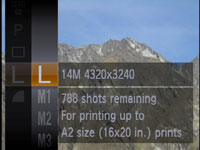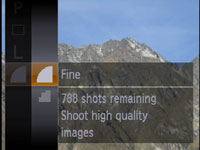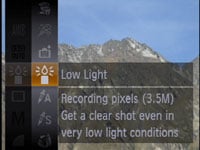Canon IXUS 130 / PowerShot SD1400 IS
-
-
Written by Gordon Laing
Intro
Canon’s IXUS 130 (or PowerShot SD1400 IS Digital ELPH as it’s known in North America) is an ultra-slim 14.1 Megapixel compact with a 4x optically-stabilised zoom and 2.7in screen.
Announced in February 2010, it’s the successor to the popular IXUS 100 IS / PowerShot SD780 IS. In 2009 the IXUS 100 IS / SD780 IS was the slimmest model in the range at just 18.4mm thick and this year Canon’s impressively managed to shave-off a further 0.6mm from the new model. Eagle-eyed readers will notice Canon’s also shaved-off the IS designation from the IXUS title, but don’t fear – the IXUS 130 still features Image Stabilisation.
Like its predecessor, the IXUS 130 / SD1400 IS packs 720p HD movies, scene recognition and an HDMI port into its tiny body, but this year the major enhancements (beyond a slightly slimmer body) include a broader 4x zoom range which usefully starts wider at an equivalent of 28mm, a slightly larger 2.7in screen and two extra Megapixels. Like other higher-end 2010 Canon compacts, the auto modes are now also cleverer than before, there’s new Fisheye and Miniature effects, and additional self-timers which can be triggered with a smile or wink.
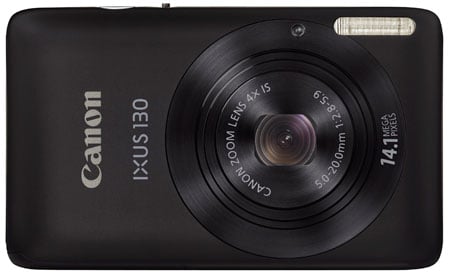 |
The really important aspect of the IXUS 130 / SD1400 IS though is its 17.8mm thickness, which combined with superb build quality makes for a camera you’ll love to handle and never leave at home.
But Canon’s not the only manufacturer with a new ultra-slim compact featuring 14 Megapixels, 720p movies, scene recognition and a 2.7in screen. Sony’s Cyber-shot DSC-350 offers all of that in a body that’s actually a tad thinner at just 16.7mm, while costing up to 20% less than the Canon.
In our full review we’ll pitch both models head-to-head, comparing their design, build, features, movie modes and of course their image quality. So if you’d like to treat yourself to an ultra-slim compact, read-on to discover which will be best for you.
Canon IXUS 130 / PowerShot SD1400 IS design and build quality
Measuring 92.2×56.1×17.8mm and weighing 133g with battery and card, the IXUS 130 / SD1400 IS is a seriously compact camera, which combined with beautifully rounded corners and lack of sharp edges will see it slip easily and comfortably into any pocket. The photos don’t do it justice as you really have to see it in the flesh to realise how much smaller it is than the vast majority of typical compacts.
It also feels great in your hands, with a smooth finish that’s almost bereft of protrusions or anything to catch your fingers on – you can’t help but turn it in your hands with a satisfied look on your face. Despite its discreet size though, you should get used to people wanting to handle it in person as it’s a camera which can’t help but grab attention.
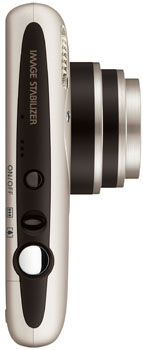 |
 | |||||||||
|---|---|---|---|---|---|---|---|---|---|
|
So it’s obvious we love the design, but it’s important to take a quick reality-check as while the IXUS 130 / SD1400 IS is indeed slimmer than its predecessor, it’s actually 1.6mm wider and 5mm taller – and that’s even though it’s lost the optical viewfinder of the older model. It’s also revealing to note Sony’s Cyber-shot DSC-W350 is actually smaller in every dimension at a mere 90.7×51.5×16.7mm.
But while the earlier IXUS 100 IS / SD780 IS was already a curvy model which also avoided sharp edges, the new IXUS 130 / SD1400 IS manages to be a little more rounded still and quite organic-looking as a result – this becomes most obvious when viewed from above. It also feels a world-apart from the conventional angular body of the Sony W350, which despite being a little smaller, just doesn’t feel as nice in your hands. Canon should be commended on a superb piece of industrial design – and if you don’t like the black finish pictured above, Canon also offers the IXUS 130 / SD1400 IS in silver, orange or pink. If you’d really like to make a splash, Canon also offers the optional WP-DC37 waterproof housing that’ll protect the camera at depths of 40m.
While the IXUS 130 / SD1400 IS looks and feels great, there are inevitably concerns over a lack of grip on what’s essentially a smooth, featureless surface front and back, without even a raised logo to press your finger against. But like its predecessor, the semi-matt finish provides surprisingly effective purchase. Your right middle finger naturally bends and rests on the front surface without slipping, while your thumb finds some grip in the tiny mode switch on the rear. You really can hold the camera quite comfortably and confidently in one hand.
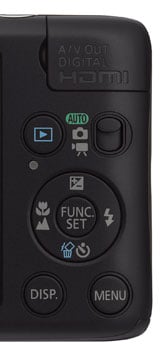 |
The controls on the rear are essentially unchanged from the older model, with the same button layout and three-way mode switch. Push this switch to the top and the camera becomes fully automatic with scene detection. Push it down and you’re in the movie mode. Leave it in the middle and you can choose from a variety of scene presets, special effects and the Program mode which we used for most of our test shots; we have full details of the modes and exposure options further down this page.
On the top you’ll find a small circular power button and silver shutter release, but Canon’s swapped the rotary zoom rocker of its predecessor for a tiny joystick lever. This actually feels better than the similar control on the PowerShot SX210 IS, but ultimately we still prefer a rotary zoom control around the shutter release even if, as on the earlier IXUS 100 IS / SD780 IS, it was quite recessed.
In the upper right corner of the rear surface you’ll find the same flap as before, hiding the combined USB / AV output and Mini HDMI port; USB and AV cables are supplied, but as usual you’ll need to provide your own HDMI cable. Note the HDMI port isn’t active during composition, although you can monitor the live feed over the standard definition TV output. The presence of a standard HDMI port on the Canon is an advantage over the Sony Cyber-shot W350, which at best offers an analogue component HD output, and even then only with an optional proprietary accessory cable.
The IXUS 130 / SD1400 IS is powered by the same NB-4L rechargeable Lithium Ion battery pack as its predecessor. Canon claims it’s good for 230 shots under CIPA conditions – a slight improvement over the 210 quoted for the IXUS 100 IS / SD780 IS and roughly the same as the 240 quoted by Sony for the Cyber-shot W350. The battery pack can also be switched for the optional ACK-DC60 AC adapter kit for mains operation.
In terms of memory, the IXUS 130 / SD1400 IS unsurprisingly uses the SD format, and like most 2010 compacts, supports the latest SDXC standard for cards bigger than 32GB. Like other Canon compacts, there’s no built-in memory, so you’ll need to fit a card before you can take any photos or video. Canon recommends cards rated as Class 4 or faster to smoothly support the HD video, but at least that includes affordable models like SanDisk’s Ultra II range; we verified Ultra II cards worked fine with the HD movie mode. The SD slot is housed in the battery compartment, and alongside the door, just off-centre is a metal tripod thread.
Canon IXUS 130 / PowerShot SD1400 IS lens and stabilisation
The Canon IXUS 130 / SD1400 IS is equipped with a new 4x optical zoom, equivalent to 28-112mm. This is not only broader than the basic 3x (33-100mm equivalent) range of its predecessor, but starts a little wider as well as zooming a little longer. It’s still nowhere near the range you’d get from super-zoom models like the SX210 IS, but equally they’re nowhere near as slim. So we’d like to thank Canon for finally equipping this desirable little camera with genuine wide-angle capabilities.
Gratifyingly, not only is the new lens wider, it’s a little brighter than its predecessor too, with a maximum aperture of f2.8-5.9 compared to f3.2-5.8, although the closest focusing distance of 3cm remains the same. You can see an example of its coverage below, and further examples of how you can use it in our sample images Gallery.
Canon IXUS 130 / SD1400 IS coverage wide | Canon IXUS 130 / SD1400 IS coverage tele | |
 |  | |
| 5-20mm at 5mm (28mm equivalent) | 5-20mm at 20mm (112mm equivalent) |
In practice the IXUS 130 / SD1400 IS’s 28-112mm equivalent coverage is great for general-purpose use, and more flexible than its predecessor. Coincidentally Sony’s Cyber-shot W350 also shares a 4x optical range, but starts a little wider still at an equivalent of 26mm, while ending a fraction shorter at 105mm. Wide-angle connoisseurs may find the Sony range preferable, but there’s not much in it for everyone else. Both are great ranges to have on such small cameras.
The Canon lens extends very quickly upon power-up with the camera ready for action in around 1.2 seconds – about half a second faster than its predecessor, so you’re certainly not kept waiting. As described earlier, the zoom is operated by a tiny joystick lever with the IXUS 130 IS / SD1400 IS offering eight steps between wide and telephoto.
Despite Canon choosing to drop the IS label from the IXUS brand in 2010, the IXUS 130 definitely features Image Stabilisation; interestingly the identical North American SD1400 IS version still has the label though. Branding aside, the IXUS 130 / SD1400 IS offers the same three stabilisation modes as its predecessor: Continuous where the system operates all the time, Shoot Only which only applies stabilisation as you take the photo, and Panning which only stabilises in the vertical axis for when you’re moving the camera horizontally as you take the photo – for an example of using the latter, see the Blurring Action tutorial at our sister site, DSLR Tips. You can also switch off stabilisation for use on tripods, although the camera should detect this when set to Auto, at least for night scenes.
Canon IXUS 130 / PowerShot SD1400 IS Image Stabilisation off / on (Continuous) | ||
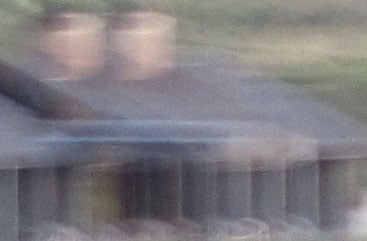 | 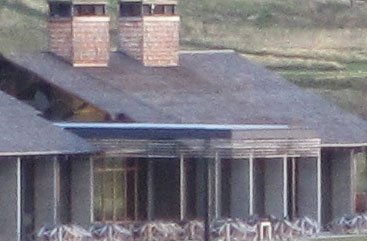 | |
100% crop, 5-20mm at 20mm, 1/15, 100 ISO, IS off | 100% crop, 5-20mm at 20mm, 1/15, 100 ISO, IS on | |
Above are examples taken with and without the default Continuous stabilisation using the IXUS 130 / SD1400 IS fully zoomed-into its maximum equivalent of 112mm, and at a shutter speed of 1/15. Traditional photographic advice would recommend a shutter speed of at least 1/100 to eliminate camera shake at this focal length, but the stabilised IXUS 130 / SD1400 IS allowed us to capture sharp handheld shots at 1/15, which corresponds to around three stops of compensation.
Unfortunately we’re unable to quote an equivalent figure for the Sony W350, as its inability to manually switch off the stabilisation means we’re unable to perform a direct before and after direct comparison.
Ultimately though, the IXUS 130 / SD1400 IS’s stabilisation makes handholding a viable proposition even at relatively slow shutter speeds, although remember like all stabilisation systems it’ll only iron-out wobbles, not freeze a subject in motion.
Canon IXUS 130 / PowerShot SD1400 IS screen and menus
 |
The Canon IXUS 130 / SD1400 IS is equipped with a 2.7in screen, which is a little larger than the 2.5in of its predecessor, although both share the same 230k resolution. A bigger screen is always nice to have, but sadly on the IXUS 130 / SD1400 IS, it’s come at the cost of losing the optical viewfinder of its predecessor. Unusually for its tiny size, Canon managed to squeeze an optical viewfinder into the earlier IXUS 100 IS / SD780 IS, which while delivering a tiny image, was at least a useful alternative for composing in bright direct light or to squeeze a few extra shots out of a failing battery.
Optical viewfinders are however becoming unfashionable on modern compacts, so it’s not entirely surprising to find this feature missing in favour of a slightly bigger screen. Some will be sad to see it go, but the good news is the screen on the IXUS 130 / SD1400 IS is at least very good quality and quite visible in bright light, not to mention at shallow angles when held low to the ground or high overhead. This is in some contrast to the screen on Sony’s W350, which while sharing the same 2.7in / 230k specification, proved to be much less visible with direct sunlight shining onto it, or when held at high or low angles.
We shot our gallery images with both cameras side-by-side, using a low angle on the first image and a high angle on the second. In both cases the Canon screen remained bright and visible whereas the Sony’s image virtually disappeared; indeed the latter proved almost impossible to compose with at high or low angles, so if that’s your style of shooting, you’ll be much better served by the Canon.
When taking photos, there’s just two main display views: one with a clean image, and the other with shooting information, switched using the DISP button. A three-by-three grid can be enabled for both views in the menus, but like most cameras in its class, there’s no live histogram.
 |  | 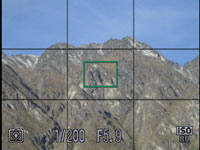 |
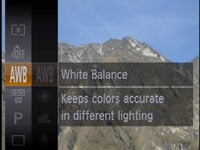 | 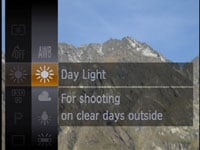 |
In terms of on-screen controls, the IXUS 130 / SD1400 IS employs the latest version of Canon’s superimposed menu system, as seen on most of its higher-end 2010 models. Pressing the FUNC SET button presents a vertical list of options running down the left hand side of the screen. This list scrolls up and down with the available options popping-out to the right in another vertically scrolling list. If ‘Hints and Tips’ are enabled in the main menus, you’ll be given a brief message helpfully describing what it’ll do.
It’s a nice touch, although some explanations could go further for beginners – for example switch the White Balance to Tungsten and the IXUS 130 / SD1400 IS will say “For Shooting under Tungsten Lighting”. Well, sure, that much is obvious, but perhaps giving an example like “For Shooting under Tungsten Lighting, such as indoor lamps” might be more useful. Likewise, choosing 1600 ISO will simply say “Set ISO to 1600” when it could elaborate and suggest it might be good for low light conditions.
The actual settings on offer vary according to the shooting mode, but in Program it lets you adjust the metering, My Colours options, White Balance, Sensitivity, Record Mode (see section below), Drive Mode, Image resolution and Image compression.
The various menus and options are navigated using a four-way rocker control on the rear, with the up, down, left and right presses doubling-up to offer direct access to the exposure compensation, self-timer, focus distance and flash options respectively. All the buttons are well-labelled and easy to press.
You can enter playback from shooting mode, or even from power-off, by pressing the play button. You can then use the left and right rocker buttons to cycle between images, or scroll through them at high speed by holding either button down. During playback, the DISP button cycles between a clean view and ones with basic or detailed shooting information, the latter including a brightness histogram. An additional page in playback shows a thumbnail of the image alongside an enlarged portion showing the active focus area. If the photo was taken with Face Detection, then the enlargement will show the primary subject’s face, allowing you to quickly check their expression and confirm the focus.
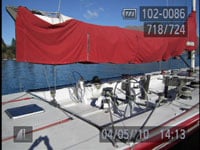 | 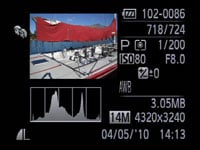 | 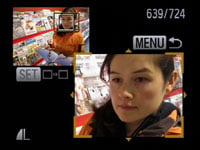 |
You can also zoom-in further on the detail if desired, or switch between other focus points – it’s a handy feature in practice. Turning the camera to the side will also rotate the image by 90 degrees to always remain upright – handy for filling the screen with a portrait aspect shot. Even the thumbnail view on the histogram page rotates as you turn the camera. Bizarrely this sensible feature isn’t widely implemented by the competition.
Pressing the Menu button while in playback presents a number of options for adjusting images including a red-eye correction mode. This uses face detection to frame the eyes of the subjects on your photos. You can then choose which frames to apply correction to and also whether you’d like the result to overwrite the original or create a new file.
Canon IXUS 130 / PowerShot SD1400 IS exposure modes
Like its predecessor, the IXUS 130 / SD1400 IS offers three main shooting modes, based on the position of a three-way switch on the back. Push the switch up and the camera becomes fully automatic, using scene detection to figure-out what you’re photographing. Push the switch down and you’re in movie mode, which we’ll fully describe in the next section below. Set the switch to its middle position and the camera becomes semi-automatic, allowing you to choose from a variety of shooting options, presets and effects.
Under the hood, the camera has access to shutter speeds between 1/1500 and 15 seconds, along with two aperture settings at any focal length (such as f2.8 or f8 when zoomed-out). Beyond being able to set the exposure between one and 15 seconds in the ‘Long Shutter’ scene preset though, the camera is fully automatic. So you’ll need to either trust the camera in Auto, or wrangle the desired result using one of the presets or effects modes. That said, few of the IXUS 130 / SD1400 IS’s target audience want manual control over exposures, and besides, the auto modes work very well in practice.
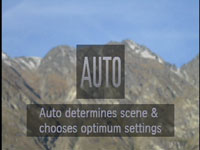 | 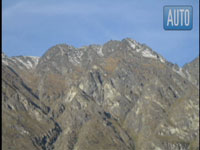 |
With the IXUS 130 / SD1400 IS set to Auto, the camera attempts to identify the subject and configure itself appropriately using scene recognition. The earlier IXUS 100 IS / SD780 IS also employed scene recognition, but the system has been enhanced on the new model, with the camera able to choose from no fewer than 22 situations allowing it to not just recognise people, landscape or close-up shots, but also the lighting conditions for each, differentiating between bright conditions, blue skies or night-time, and whether the subject is backlit or not. In each instance, the exposure and flash are adjusted accordingly, and the camera will even attempt to recognise a Sunset and boost the colours.
New to the IXUS 130 / SD1400 IS over its predecessor is the further ability to recognise people in motion, along with detecting whether the camera’s mounted on a tripod. The actual conditions or subject recognised by the camera is indicated by an icon in the top left corner, which you’ll see adjust as you recompose. You’ll need to check the manual to confirm what each icon means though, for example those taken under normal, blue or dark skies feature grey, blue or dark blue icons respectively, while backlit situations have a Sun in the corner.
Or rather than learning the icons and second-guessing the camera, you could simply relax and trust the IXUS 130 / SD1400 IS as it does a pretty good job of recognising the scene and choosing the best settings for it. In practice, the camera seamlessly switches between portrait mode with face detection when pointed at a person, or into macro mode when placed close to a subject.
We were also pleased to see the camera switch to its new ‘dark mode on a tripod’ when balanced on a ledge for a self-timed night shot you’ll see in the gallery, although despite knowing the stable conditions, it still selected a relatively high sensitivity of 800 ISO and ‘quick’ exposure of 1/8, when a slower exposure and lower ISO would have delivered better results. Canon also admits the system can mistake blue or orange walls for a glorious clear day or a spectacular sunset. That said, it’s as good a system as any of the competition and one we’d be happy to trust for most day-to-day shots.
If you prefer a bit of control, set the switch to its middle position and choose from 19 different recording options. The first option is Program, naturally followed by a number of scene presets, but the remaining selection is fairly eclectic and feels almost like Canon didn’t really know where else to put them. Scroll through the options and you’ll find Canon’s Colour Accent and Colour Swap modes, a pair of Stitch Assistance options for creating panoramas, a Low Light mode which drops the resolution to 3.5 Megapixels, a Long Shutter option which lets you manually choose a shutter speed between one and 15 seconds, two new effects (see below) and an enhanced Smart Shutter mode which now allows you to trigger the self-timer by a smile or wink. Why the latter isn’t part of the normal self-timer options is a mystery, and in protest we’ll describe it lower on this page in the Drive mode section.
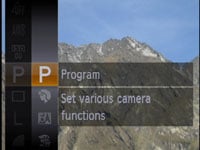 | 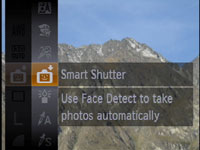 | 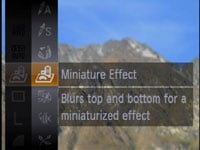 |
For now though, here’s two images taken from the same position showing the new Fish-eye and Miniature filter effects using their default settings; it’s possible to vary the strength of the fisheye distortion along with adjusting the position of the band of focus in the Miniature mode.
Canon IXUS 130 / SD1400 IS: Fisheye preset | Canon IXUS 130 / SD1400 IS: Miniature preset | |
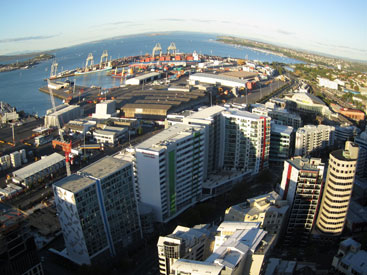 |  | |
| Fisheye preset : 5-20mm at 5mm (28mm equiv) | Miniature preset : 5-20mm at 16mm (90mm equiv) |
The IXUS 130 / SD1400 IS also offers automatic dynamic range adjustments using its i-Contrast feature (disabled by default). i-Contrast automatically boosts shadow areas or faces darkened by strongly backlit scenes. To put it to the test we took two photos of a Church interior with and without i-Contrast set to its Auto option. This composition features dark shadow areas and strong window lighting which represents a challenge for any camera’s exposure system.
| ||||||||||||||||
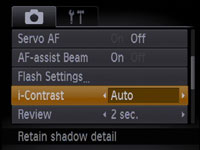 | 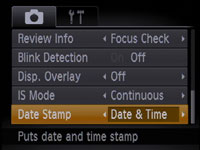 |
The example above shows i-Contrast selecting the same exposure when set to its Auto mode, and while there’s no detail retrieved in the saturated windows, the darker areas such as the roof, flooring and benches have certainly received a boost.
The histograms below each image give a better idea of what’s going on, with a reduction in darker shadow areas and a boost in upper mid-tones, albeit still with clipping in the highlights. Like other systems which boost shadow areas, there’s inevitably an increase in visible noise as a result, especially if you’re using anything but the lowest sensitivity.
Finally, the Date Stamp option allows the time, date or both to be permanently written in the corner of the image. Such digital mutilation may horrify many photographers, especially considering the date and time are always present in the EXIF data of the file itself, but we’ve heard from sufficient numbers of people who want the feature to know it’s something of value.
Canon IXUS 130 / PowerShot SD1400 IS focusing and face detection
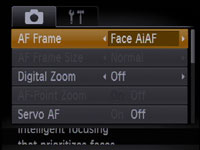 | 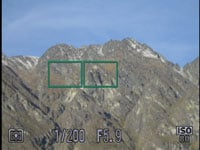 |
The Canon IXUS 130 / SD1400 IS offers two main auto-focusing options: Face AiAF and Centre. The default Face AiAF automatically switches between face detection when a human subject is in the frame and a standard nine-area system for other subjects. It works seamlessly in practice, and like other Canon compacts employing DIGIC 4 processors, the face detection can hang-onto most subjects as they move across the frame or turn to full profile.
Alternatively you can select Centre which as its name suggests, simply focuses on a central area, although you can adjust the size of the frame if desired. This mode gives you more control and by dispensing with an automatic selection is fractionally quicker, but in use we found the default Face AiAF option was fast and virtually foolproof.
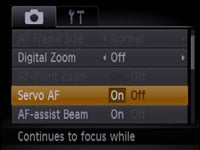 |
Like its predecessor, the IXUS 130 / SD1400 IS can recognise subjects who blink as you take the shot, with an optional warning if enabled. The new model can also recognise smiles and these capabilities are exploited in a clever update to the self-timer options we’ll detail in the Drive mode section.
Like other DIGIC 4 models, the IXUS 130 / SD1400 IS also offers a Servo AF mode which tracks a subject while the shutter release is half-pressed. In use this proved effective when photographing fairly leisurely distant subjects like the approaching Steamship in our Gallery section, but the disappointingly slow continuous shooting options effectively rule out any action photography.
Canon IXUS 130 / PowerShot SD1400 IS Movie Mode
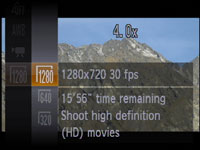 |
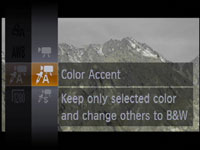 |
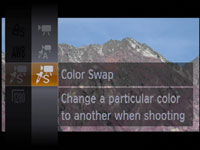 |
|
The Canon IXUS 130 / SD1400 IS inherits essentially the same Movie quality as its predecessor. You can film at 320×240, 640×480 or 1280×720 pixels, all at 30fps (29.97 actual), and you now have the additional choice of applying Canon’s Colour Swap or Colour Accent modes for special effects. The best quality setting shoots 720p HD video and Canon recommends using a Class 4 or faster card; we verified the HD movie mode worked file with an affordable Class 4 SanDisk Ultra II card, along with quicker Class 6 models.
Like most Canon models which employ DIGIC 4, the IXUS 130 / SD1400 IS compresses its video using the H.264 format and encodes audio as Linear PCM at 16 bit / 44.1KHz, then stores the result in a QuickTime MOV wrapper.
The maximum recording time is approximately ten minutes in HD or one hour in the other formats, or when the file size reaches 4GB. A ten minute HD clip will consume around 2GB of space. This ten minute limitation on HD clips is a little strange since several other 2010 Canon compacts allow you to record just over double that in a single file before reaching the 4GB capacity limit.
Annoyingly you still can’t operate the optical zoom once you start filming; instead you’re restricted to a 4x digital zoom while recording which greatly reduces the quality, albeit operating in silence. We know most small cameras will record the sound of the zoom motor while filming, but we’d still prefer to have the option to optically zoom – if the motor noise irritates, you can always dub music or other sounds over it later.
We have an example video here shot handheld in the best-quality HD mode, showing the digital zoom towards the end of the clip; stabilisation was enabled.
As always, registered members of Vimeo can download the original file. We also have a tripod-based daylight shot without stabilisation to download here, and a handheld low-light bar clip to download here. We recommend using VLC Player under Windows if the QuickTime Player isn’t delivering smooth results.
The actual quality is essentially unchanged from the original IXUS 100 IS / SD780 IS. The 720p HD mode looks pretty good, although like its predecessor the image processing is a little laid-back resulting in a soft and muted appearance at times. Like most compacts which use CCD sensors, there’s also the risk of vertical streaking lines in saturated areas, such as bright sunlight reflecting from ripples in water (as seen in our sample clip above), or on strongly backlit windows.
Canon IXUS 130 / PowerShot SD1400 IS Drive Modes
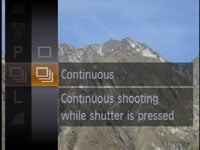 |
Continuous shooting has never been a strong point of most Canon compacts, and sadly the IXUS 130 / SD1400 IS doesn’t break the mould. There’s only one Continuous Drive mode here, and it shoots at just 0.7fps. That’s right, you’re looking at firing-off a frame every 1.4 seconds and to add insult to injury, the screen also blacks-out between each frame, making it almost impossible to follow any action. Indeed as you hold the shutter release button down, urging the camera to take another shot during each agonising pause, you wonder if it’s even set to ‘burst’ at all. Sadly it is.
Offering some consolation is the Low Light mode, which fired-off ten shots in 7.6 seconds in our tests – at 1.3fps, that’s still pretty slow, but a little quicker than the main Continuous shooting mode. The downside to the Low Light mode though is a significantly reduced resolution of 3.5 Megapixels. Suffice it to say the IXUS 130 / SD1400 IS (like most Canon compacts) is not for you if you’re into shooting action of any description.
While the IXUS 130 / SD1400 IS is dismal at continuous shooting though, it is rather good at self-timer photos. Beyond the usual two and ten second countdowns along with a custom option which fires-off between one and ten shots after a delay of 0 to 30 seconds, the IXUS 130 / SD1400 IS offers Smile, Wink and Face timers, which delay the countdown until they see the subject either smile or wink or until a new face enters the frame.
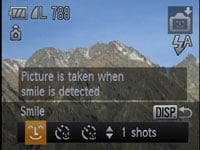 | 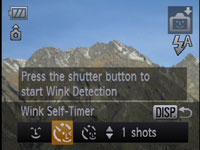 | 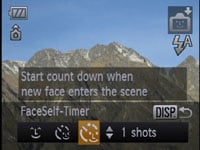 |
These sound like a novelty, but they’re actually both fun and useful in practice. Unfortunately though for some bizarre reason you won’t find any of them in the self-timer menu. Instead to use the Face, Smile and Wink timers, you’ll need to change the shooting mode to Smart Shutter and select them there.
This is just plain daft. Why do you need to enter a scene preset to access these modes, when they really ought to be listed in the normal self-timer menu? After all, the ‘face-timer’ of previous Canon compacts was listed alongside the normal self-timer options, so why it’s moved is a mystery. Sadly without reading the manual (or a detailed review), many owners may not even realise these options exist. So ten-out-of-ten for cleverly exploiting face detection on the self-timer, but minus-several-million for hiding them away.
|
Canon IXUS 130 / PowerShot SD1400 IS sensor
The IXUS 130 / SD1400 IS is equipped with a 14.1 Megapixel CCD sensor which measures 1/ 2.3in and delivers 4:3 shaped images with a maximum resolution of 4320×3240 pixels. This matches the resolution of the Sony Cyber-shot DSC-W350 and gives the latest IXUS a two Megapixel boost over its predecessor. Check out our results pages for a direct comparison between the Canon IXUS 130 / SD1400 IS and Sony W350.
The IXUS 130 / SD1400 IS offers four lower resolutions and a cropped 16:9 option, along with the choice of Fine and Normal JPEG compression; unsurprisingly there’s no RAW option on this, or the other ultra-slim compacts.
Best quality Large Fine JPEGs measure around 3.7MB each, and like all Canon compacts, there’s no built-in memory to get you started so you’ll need to provide your own card from day-one. As discussed above, the IXUS 130 / SD1400 IS is compatible with SD, SDHC and the latest SDXC cards, with Class 4 or faster models required to support the HD movie mode.
The sensitivity ranges from 80 to 1600 ISO at the full resolution, with the Low Light Scene Preset automatically operating between 400 and 4000 ISO, albeit at a greatly reduced resolution of 3.5 Megapixels; there’s no adjustments for noise reduction.
To see how the quality of the IXUS 130 / PowerShot SD1400 IS measures-up in practice, take a look at our real-life resolution and high ISO noise results pages, browse the sample images gallery, or skip to the chase and head straight for our verdict.

